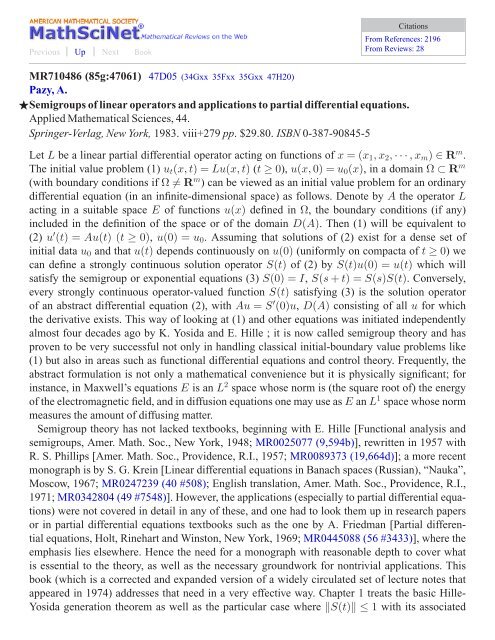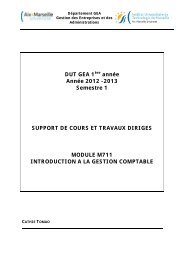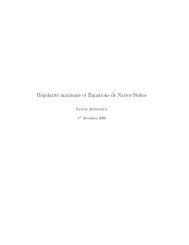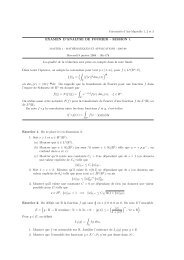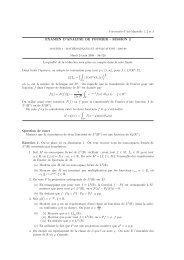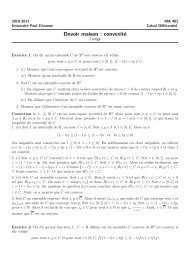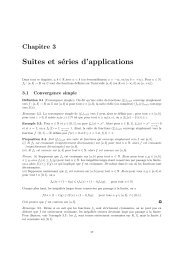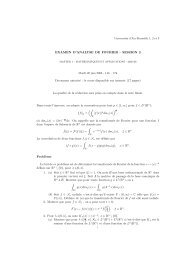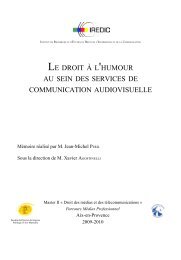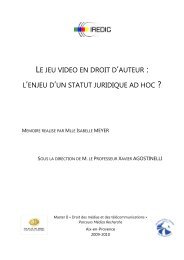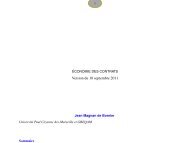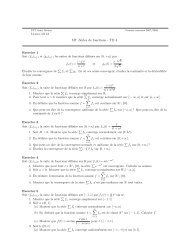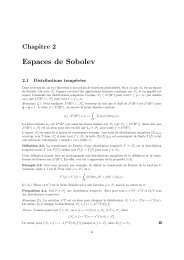Semigroups of linear operators and applications to partial differential ...
Semigroups of linear operators and applications to partial differential ...
Semigroups of linear operators and applications to partial differential ...
You also want an ePaper? Increase the reach of your titles
YUMPU automatically turns print PDFs into web optimized ePapers that Google loves.
Previous Up Next Book<br />
Citations<br />
From References: 2196<br />
From Reviews: 28<br />
MR710486 (85g:47061) 47D05 (34Gxx 35Fxx 35Gxx 47H20)<br />
Pazy, A.<br />
⋆<strong>Semigroups</strong> <strong>of</strong> <strong>linear</strong> <strong>opera<strong>to</strong>rs</strong> <strong>and</strong> <strong>applications</strong> <strong>to</strong> <strong>partial</strong> <strong>differential</strong> equations.<br />
Applied Mathematical Sciences, 44.<br />
Springer-Verlag, New York, 1983. viii+279 pp. $29.80. ISBN 0-387-90845-5<br />
Let L be a <strong>linear</strong> <strong>partial</strong> <strong>differential</strong> opera<strong>to</strong>r acting on functions <strong>of</strong> x = (x 1 , x 2 , · · · , x m ) ∈ R m .<br />
The initial value problem (1) u t (x, t) = Lu(x, t) (t ≥ 0), u(x, 0) = u 0 (x), in a domain Ω ⊂ R m<br />
(with boundary conditions if Ω ≠ R m ) can be viewed as an initial value problem for an ordinary<br />
<strong>differential</strong> equation (in an infinite-dimensional space) as follows. Denote by A the opera<strong>to</strong>r L<br />
acting in a suitable space E <strong>of</strong> functions u(x) defined in Ω, the boundary conditions (if any)<br />
included in the definition <strong>of</strong> the space or <strong>of</strong> the domain D(A). Then (1) will be equivalent <strong>to</strong><br />
(2) u ′ (t) = Au(t) (t ≥ 0), u(0) = u 0 . Assuming that solutions <strong>of</strong> (2) exist for a dense set <strong>of</strong><br />
initial data u 0 <strong>and</strong> that u(t) depends continuously on u(0) (uniformly on compacta <strong>of</strong> t ≥ 0) we<br />
can define a strongly continuous solution opera<strong>to</strong>r S(t) <strong>of</strong> (2) by S(t)u(0) = u(t) which will<br />
satisfy the semigroup or exponential equations (3) S(0) = I, S(s + t) = S(s)S(t). Conversely,<br />
every strongly continuous opera<strong>to</strong>r-valued function S(t) satisfying (3) is the solution opera<strong>to</strong>r<br />
<strong>of</strong> an abstract <strong>differential</strong> equation (2), with Au = S ′ (0)u, D(A) consisting <strong>of</strong> all u for which<br />
the derivative exists. This way <strong>of</strong> looking at (1) <strong>and</strong> other equations was initiated independently<br />
almost four decades ago by K. Yosida <strong>and</strong> E. Hille ; it is now called semigroup theory <strong>and</strong> has<br />
proven <strong>to</strong> be very successful not only in h<strong>and</strong>ling classical initial-boundary value problems like<br />
(1) but also in areas such as functional <strong>differential</strong> equations <strong>and</strong> control theory. Frequently, the<br />
abstract formulation is not only a mathematical convenience but it is physically significant; for<br />
instance, in Maxwell’s equations E is an L 2 space whose norm is (the square root <strong>of</strong>) the energy<br />
<strong>of</strong> the electromagnetic field, <strong>and</strong> in diffusion equations one may use as E an L 1 space whose norm<br />
measures the amount <strong>of</strong> diffusing matter.<br />
Semigroup theory has not lacked textbooks, beginning with E. Hille [Functional analysis <strong>and</strong><br />
semigroups, Amer. Math. Soc., New York, 1948; MR0025077 (9,594b)], rewritten in 1957 with<br />
R. S. Phillips [Amer. Math. Soc., Providence, R.I., 1957; MR0089373 (19,664d)]; a more recent<br />
monograph is by S. G. Krein [Linear <strong>differential</strong> equations in Banach spaces (Russian), “Nauka”,<br />
Moscow, 1967; MR0247239 (40 #508); English translation, Amer. Math. Soc., Providence, R.I.,<br />
1971; MR0342804 (49 #7548)]. However, the <strong>applications</strong> (especially <strong>to</strong> <strong>partial</strong> <strong>differential</strong> equations)<br />
were not covered in detail in any <strong>of</strong> these, <strong>and</strong> one had <strong>to</strong> look them up in research papers<br />
or in <strong>partial</strong> <strong>differential</strong> equations textbooks such as the one by A. Friedman [Partial <strong>differential</strong><br />
equations, Holt, Rinehart <strong>and</strong> Wins<strong>to</strong>n, New York, 1969; MR0445088 (56 #3433)], where the<br />
emphasis lies elsewhere. Hence the need for a monograph with reasonable depth <strong>to</strong> cover what<br />
is essential <strong>to</strong> the theory, as well as the necessary groundwork for nontrivial <strong>applications</strong>. This<br />
book (which is a corrected <strong>and</strong> exp<strong>and</strong>ed version <strong>of</strong> a widely circulated set <strong>of</strong> lecture notes that<br />
appeared in 1974) addresses that need in a very effective way. Chapter 1 treats the basic Hille-<br />
Yosida generation theorem as well as the particular case where ‖S(t)‖ ≤ 1 with its associated
theory <strong>of</strong> dissipative <strong>opera<strong>to</strong>rs</strong> in Banach spaces. Chapter 2 deals, among other things, with analytic<br />
semigroups <strong>and</strong> semigroups <strong>of</strong> compact <strong>opera<strong>to</strong>rs</strong>. Chapter 3 is on perturbation <strong>of</strong> genera<strong>to</strong>rs<br />
<strong>and</strong> approximation <strong>of</strong> semigroups both in the continuous <strong>and</strong> in the discrete case. Chapter 4 studies<br />
the relation <strong>of</strong> the abstract <strong>differential</strong> equation (2) with strongly continuous semigroups.<br />
During the 1960s <strong>and</strong> 1970s, semigroup theory extended in at least three (<strong>partial</strong>ly overlapping)<br />
directions. The first deals with distribution solutions <strong>of</strong> (2), the second with abstract timedependent<br />
equations u ′ (t) = A(t)u(t) <strong>and</strong> the third with non<strong>linear</strong> abstract <strong>differential</strong> equations.<br />
The last two are covered in the book in Chapters 5 <strong>and</strong> 6, respectively; the non<strong>linear</strong> equations here<br />
are mostly quasi<strong>linear</strong>, i.e., non<strong>linear</strong> perturbations <strong>of</strong> (2) <strong>of</strong> the form u ′ (t) = Au(t) + f(t; u(t)).<br />
Finally, Chapters 7 <strong>and</strong> 8 are on <strong>applications</strong> <strong>to</strong> <strong>partial</strong> <strong>differential</strong> equations, both <strong>linear</strong> <strong>and</strong><br />
non<strong>linear</strong>.<br />
The few prerequisites needed <strong>and</strong> the clear exposition make this monograph an excellent textbook<br />
for a graduate course or for part <strong>of</strong> a functional analysis or a <strong>partial</strong> <strong>differential</strong> equations sequence<br />
(although the lack <strong>of</strong> exercises does not help here). It presents a reasonably complete <strong>and</strong> deep<br />
overview <strong>of</strong> an important theory <strong>and</strong> <strong>of</strong> some <strong>of</strong> its <strong>applications</strong>; thus it will be <strong>of</strong> interest <strong>to</strong> users<br />
<strong>of</strong> <strong>partial</strong> <strong>differential</strong> <strong>and</strong> other equations. Finally, it <strong>of</strong>fers the <strong>to</strong>ols necessary for access <strong>to</strong> areas<br />
<strong>of</strong> mathematics where important research is presently going on, chiefly the theory <strong>of</strong> non<strong>linear</strong><br />
semigroups. On these <strong>and</strong> other counts, it is a welcome addition <strong>to</strong> the literature.<br />
Reviewed by H. O. Fat<strong>to</strong>rini<br />
c○ Copyright American Mathematical Society 1985, 2011


